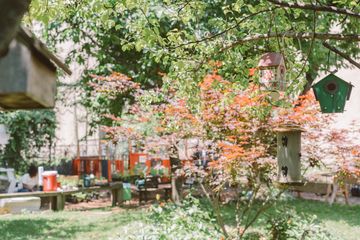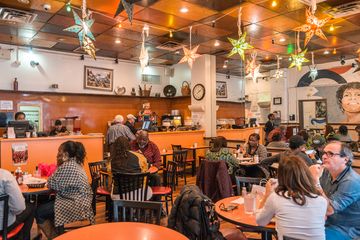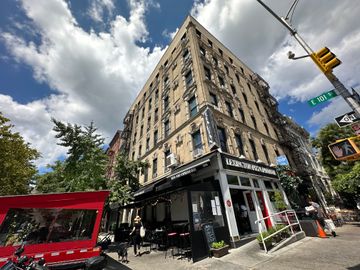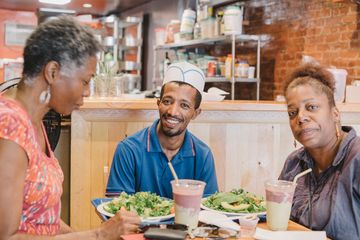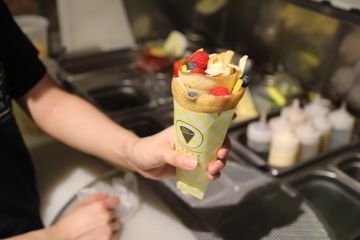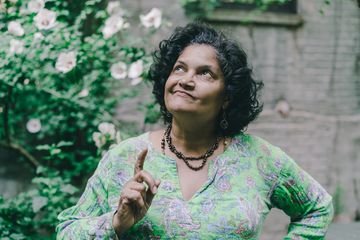Like so many of the amazing community gardens throughout Manhattan, stepping into Harlem Grown is like entering an oasis in the middle of the city. Beyond the gates is a carefully cultivated grassy area surrounded by neatly labeled patches of fruits and vegetables and colorful flowerpots. The distinct difference, however, is on our first meeting with Tony Hillery - the founder of the organization behind Harlem Grown - is that when I introduced myself to him explaining that Manhattan Sideways was interested in learning about the garden, he immediately replied, "Excuse me, I have to correct you, it is our farm. " Listening to the variety of birds chirping around us during the summer of 2017, while sitting and chatting with Tony Hillery, was a unique Manhattan experience. Harlem Grown sprouted in 2011, when Tony decided to leave his successful limousine business in favor of finding something that he felt was "more worthwhile. " He told us that he started out with no master plan, and just had a general idea about getting involved with the local public school on 134th Street. His hope was that he could teach parents that education is the way out of poverty. Three weeks into his program, he had a conversation with one of the mothers at the school that permanently altered his understanding of the problem at hand, as she maintained that she lived a perfectly good life despite never having received an education. He was blown away to think that for some living in low-income housing, feeding their children on food stamps, and depending on benefits was the best or only lifestyle to aspire to. This, he explained, was his introduction to what he defines as "generational poverty. " The encounter sparked a realization that simply telling parents about the importance of education was ineffective, because it ignored the reality they were facing. Tony proceeded to share with us a series of alarming statistics about the community: 80% of the kids in the area come from single-parent homes, 98% percent of them live on food stamps, 92% percent of them live in poverty, and 40% of them are homeless. Tony decided to change tactics and embrace a “from the ground up” approach that focused on mentoring children and improving every aspect of their lives. "What we are fighting is generational poverty. "One of the issues he identified, immediately, was the amount of altercations that happen between children in the school, usually during lunch time in the cafeteria. He clarified that the kids at the school were not predisposed to violence, they were just scared, angry, confused, and hungry as a result of their circumstances. “I’m a fifty-eight-year-old man, and if I’m even one of those I can get ornery myself, ” he remarked. With this in mind, he decided to find something that the kids could get involved with, serving his purpose of educating them as well as giving them a productive outlet for their energies. First off, Tony began a recycling program in the school, and the students quickly became enthusiastic about participating, forming a green team, a composting program, and even organizing a salad bar in the cafeteria. Tony was pleased to tell us that as the students became more engaged in this project, the number of arguements in the cafeteria dropped from six to eight incidents a week to zero. With the success of his in-school program, Tony began thinking of what he could offer outside of school. This, in turn, led him to contact the city to request a license for the plot of land on 134th Street that had been intended as a community garden. The space was overgrown after being neglected for six years, and it had been taken over by people engaging in illegal activities. In fact, Tony revealed that in his first year of trying to clean out the land and set up the farm, he had to contend with numerous acts of sabotage from people in the neighborhood upset at losing their hangout spot - including vandalism and chemicals thrown over the gate to contaminate the land and plants. While we were sitting on a bench near the gate of the garden, I commented on so many of the people passing by saying a quick "hello boss, " referring to him in the most sincere and warmest way. Tony revealed that many of them were those same people that he had to force out of his space a few years back. Despite the initial resistance from the people who were using the garden, Tony persisted. He was soon joined by several students at school who were eager to help clean up the space, which snowballed into people from the neighborhood asking if they could volunteer, too. He remade the former community garden into what he calls a “youth garden, ” which he inaugurated with a seedling ceremony where each child planted something. This instantly won him the dedication of each of those children, as they were all naturally excited to watch what they had planted grow. Better yet, Tony found, “if they plant it, they will eat it. ” Kids that proclaimed to hate vegetables would happily eat them if they were involved in the growing process. He even said that he found that eight out of ten kids acquired a taste for vegetables over time. However, this is when yet another component of the issue Tony was combating made itself known. He described the neighborhood as a “food desert, ” which is when the population of an area lacks access to affordable, fresh, healthy food. We were shocked to learn that in a three-block radius, there are 53 fried chicken restaurants, 29 pharmacies, and not one affordable healthy food option. As such, even as children were becoming excited about fresh produce, there were no markets from which families could purchase them. Tony’s solution to this is to allow his volunteers to take home 100% of what is grown in their farm and their greenhouse next door, which produces 10, 000 vegetable plants per month. Tony then told us that he goes a step farther by offering cooking lessons on Saturdays so that children and their families can learn what to make with healthy, fresh ingredients. This exemplifies the effectiveness of the “education from the bottom up model, " as it is through engaging the kids that Tony is then able to access and educate their parents. “What we’re really growing is well-adjusted little humans. ” He went on to say that he knows the children, the boys in particular, tend to mimic him and follow his example. He attributes this to another significant issue the children face - namely, a lack of positive male role models. Less than 20% of teachers in public elementary and middle schools are male. Nationally, only 2% of teachers are men of color. Statistics like these bolster his belief in the importance of mentorship, a philosophy that is an integral part of both his organization as a whole and his individual interactions with the kids he serves, as he acts as their surrogate dad of sorts. We were able to witness this in action during our conversation, as he traded jokes with a visiting group of high school students and confessed to us, “They eat that goofy stuff up. ”Moreover, Tony also works with the Police Athletic League and the Harlem Justice Corps, giving internship opportunities to young men, many of whom have been imprisoned and are unemployed. He shared with us that most of these men want to work and be productive but do not know how, due to a lack of employable skills or a shortage of opportunities. For those who show a great deal of promise during the internship, he goes on to offer them "real" employment with Harlem Grown under the condition that they get their GED, open a bank account, and acquire financial literacy. Once these young men are educated and have been influenced by Tony’s mentoring, he then sends them to the public schools to be the new mentors to the next group of students, following the methods Tony initiated. Tony said that there are about eight men who have undergone this process and are now the employees at six public schools in the area, all of which have their own gardens and in-school programs. One cannot underestimate the importance of the great number of passionate and exceptional people Harlem Grown employs. While we were visiting, we had the chance to meet Vanessa. Smiling, Tony said, “She has one job title but does five jobs. ” He was pleased to share with us that she left a high power job on Wall Street in an effort to give back and help those in need. She started working for him in 2015 and is in charge of development, social media, mentoring high school girls, scheduling, marketing, and more. Tony emphasized that Vanessa Vincent best embodies everything he wants Harlem Grown to be. Tony finds that having these positive examples makes a real, tangible difference in the children’s lives. "When I first started, every boy wanted to be LeBron James and every girl wanted to be Beyonce. Six years later, these kids want to be CPAs or coders, " he noted. “We shoot high here. ” The older kids are given help filling out college applications, and many of them who have been with Harlem Grown since it first started are now training to be counselors for their seven-week intensive summer camp. Harlem grown hosts three to five classes of about thirty-five children a day at the garden, which adds up to 2, 300 young people passing through their gates a month. When asked what was the turning point that allowed his project to grow to such a large scale, Tony attributed it to the accounting firm PricewaterhouseCoopers. They had approached him, a few years ago, and asked if they could volunteer. The company was so impressed by what he had accomplished that they gave him funding and three consultants to determine how to replicate his results elsewhere. Today, Tony travels the country to talk to others about food insecurity, poverty, and the methods he has utilized to combat them. Throughout his travels, he is continually reminded that “this is not a black, white, or brown issue - it’s a poor issue. ” He then added, “We fight generational poverty and we use urban farming as our tool. ”Tony has gained increasing recognition and acclaim for his project, and he even surprised us by sharing that he is one of the finalists for the 2017 CNN Heroes award. Despite this, he insisted, “This story is not about me; I’m just the storyteller. The real story is the kids and the participants here. ” He then admitted to us that since starting Harlem Grown, he lives a more fulfilling life and is happy for the chance to make a positive impact on the community. He sees this impact every day when the men who used to vandalize his garden six years ago now greet him by name, having been won over by seeing the difference Tony’s project has made on the lives of their children and grandchildren. He was then quick to point out that working with these kids is equally as rewarding for him. He described the kids’ amazing response to him, saying, “I get about a hundred hugs a day. ” He reflected on the changes that Harlem Grown had caused in him, and concluded our conversation by telling us, “It’s the new me - it’s simple, it’s genuine, and what I get back from these kids is unbelievable. ”
